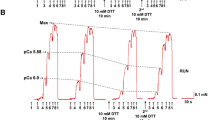Summary
Twenty 4-week-old Wistar rats exercised voluntarily in running wheels each day for 45 days. Fibre type composition, fibre cross-sectional area and the number of capillaries around a fibre of the slow-twitch soleus and fast-twitch plantaris muscles were examined and compared with animals which had no access to running wheels. The exercise group had a higher percentage of fast-twitch oxidative glycolytic (FOG) fibres and a lower percentage of fast-twitch glycolytic (FG) fibres in the deep portion of the plantaris muscle. The area of FOG fibres in the surface portion of the plantaris muscle was also greater in the exercise group. In the exercised animals, there was a positive relationship between the running distance and the area of FOG fibres in both the deep and surface portions of the plantaris muscle. In addition, the running distance correlated positively with the percentage of FOG fibres and negatively with that of FG fibres in the deep portion of the plantaris muscle. There were no relationships between the running distance and fibre type composition, or fibre area and capillary supply in the soleus muscle. These results suggested that the increase in the percentage and area of FOG fibres in the fast-twitch muscle was closely related to voluntary running.
Similar content being viewed by others
References
Adolfsson J, Ljungqvist A, Tornling G, Unge G (1981) Capillary increase in the skeletal muscle of trained young and adult rats. J Physiol 310:529–532
Andersen P (1975) Capillary density in skeletal muscle of man. Acta Physiol Scand 95:203–205
Bagby GJ, Sembrowich WL, Gollnick PD (1972) Myosin ATPase and fiber composition from trained and untrained rat skeletal muscle. Am J Physiol 223:1415–1417
Baldwin KM, Klinkerfuss GH, Terjung RL, Mole PA, Holloszy JO (1972) Respiratory capacity of white, red, and intermediate muscle: adaptative response to exercise. Am J Physiol 222:373–378
Banchero N, Gimenez M, Aquin L, Florentz M (1979) Effects of exercise on capillarity and enzymatic activity of rat skeletal muscle. Bull Eur Physiopathol Respir 15:203–216
Barnard RJ, Edgerton VR, Peter JB (1970) Effect of exercise on skeletal muscle. I. Biochemical and histochemical properties. J Appl Physiol 28:762–766
Carrow RE, Brown RE, Van Huss WD (1967) Fiber sizes and capillary to fiber ratios in skeletal muscle of exercised rats. Anat Rec 159:33–39
Dohm GL, Beecher GR, Stephenson TP, Womack M (1977) Adaptations to endurance training at three intensities of exercise. J Appl Physiol 42:753–757
Dudley GA, Abraham WM, Terjung RL (1982) Influence of exercise intensity and duration on biochemical adaptations in skeletal muscle. J Appl Physiol 53:844–850
Edgerton VR (1978) Mammalian muscle fiber types and their adaptability. Am Zool 18:113–125
Edgerton VR, Gerchman L, Carrow R (1969) Histochemical changes in rat skeletal muscle after exercise. Exp Neurol 24:110–123
Faulkner JA, Maxwell LC, Brook DA, Lieberman DA (1971) Adaptation of guinea pig plantaris muscle fibers to endurance training. Am J Physiol 221:291–297
Fitts RH, Booth FW, Winder WW, Holloszy JO (1975) Skeletal muscle respiratory capacity, endurance, and glycogen utilization. Am J Physiol 228:1029–1033
Gillespie AC, Fox EL, Merola AJ (1982) Enzyme adaptations in rat skeletal muscle after two intensities of treadmill training. Med Sci Sports Exerc 14:461–466
Gollnick PD, King DW (1969) Effect of exercise and training on mitochondria of rat skeletal muscle. Am J Physiol 216:1502–1509
Green HJ, Reichmann H, Pette D (1983) Fibre type specific transformations in the enzyme activity pattern of rat vastus lateralis muscle by prolonged endurance training. Pflügers Arch 399:216–222
Hickson RC, Heusner WW, Van Huss WD (1976) Skeletal muscle enzyme alterations after sprint and endurance training. J Appl Physiol 40:868–872
Holloszy JO (1967) Biochemical adaptations in muscle. Effects of exercise on mitochondrial oxygen uptake and respiratory enzyme activity in skeletal muscle. J Biol Chem 242:2278–2282
Holloszy JO, Oscai LB, Don IJ, Molé PA (1970) Mitochondrial citric acid cycle and related enzymes: adaptive response to exercise. Biochem Biophys Res Commun 40:1368–1373
Ljungqvist A, Unge G (1977) Capillary proliferative activity in myocardium and skeletal muscle of exercised rats. J Appl Physiol 43:306–307
Mai JV, Edgerton VR, Barnard RJ (1970) Capillarity of red, white and intermediate muscle fibers in trained and untrained guinea-pigs. Experientia 26:1222–1223
Molé PA, Oscai LB, Holloszy JO (1971) Adaptation of muscle to exercise. Increase in levels of palmityl CoA synthetase, carnitine palmityltransferase, and palmityl CoA dehydrogenase, and in the capacity to oxidize fatty acids. J Clin Invest 50:2323–2330
Müller W (1974) Temporal progress of muscle adaptation to endurance training in hind limb muscles of young rats. Cell Tissue Res 156:61–87
Nachlas M, Tsou K, DeSousa E, Cheng C, Seligman A (1957) Cytochemical demonstration of succinic dehydrogenase by the use of a new p-nitrophenyl substituted ditetrazole. J Histochem Cytochem 5:420–436
Padykula HA, Herman E (1955) The specificity of the histochemical method for adenosine triphosphatase. J Histochem Cytochem 3:170–195
Pattengale PK, Holloszy JO (1967) Augmentation of skeletal muscle myoglobin by a program of treadmill running. Am J Physiol 213:783–785
Peter JB, Barnard RJ, Edgerton VR, Gillespie CA, Stempel KE (1972) Metabolic profiles of three fiber types of skeletal muscle in guinea pigs and rabbits. Biochemistry 11:2627–2633
Staudte HW, Exerr GU, Pette D (1973) Effects of short-term, high intensity (sprint) training on some contractile and metabolic characteristics of fast and slow muscle of the rat. Pflügers Arch 344:159–168
Terjung RL (1976) Muscle fiber involvement during training of different intensities and durations. Am J Physiol 230:946–950
Author information
Authors and Affiliations
Rights and permissions
About this article
Cite this article
Ishihara, A., Inoue, N. & Katsuta, S. The relationship of voluntary running to fibre type composition, fibre area and capillary supply in rat soleus and plantaris muscles. Europ. J. Appl. Physiol. 62, 211–215 (1991). https://doi.org/10.1007/BF00643744
Accepted:
Issue Date:
DOI: https://doi.org/10.1007/BF00643744




